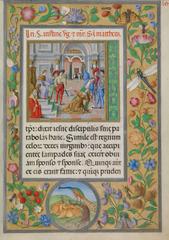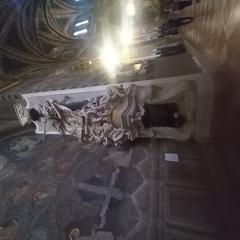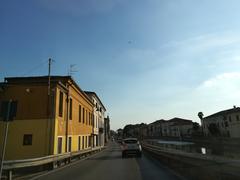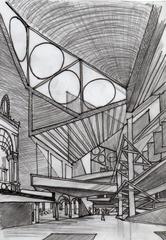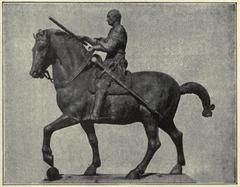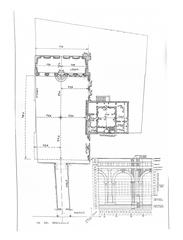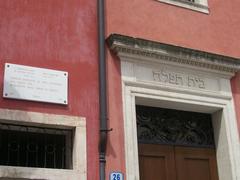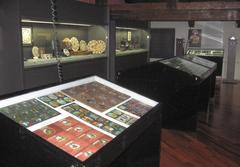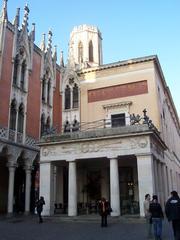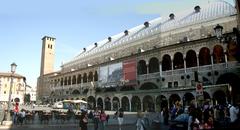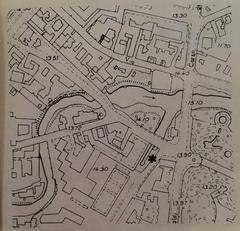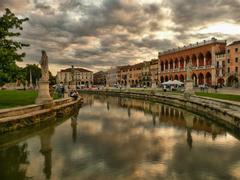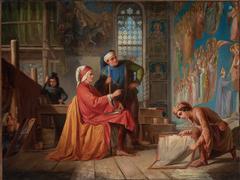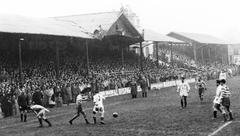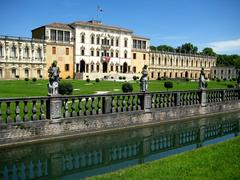Palazzo di Ezzelino: Visiting Hours, Tickets, and Historical Sites in Padua, Italy
Date: 14/06/2025
Introduction
Standing in the heart of Padua, the Palazzo di Ezzelino is one of the city’s most evocative medieval landmarks. As Padua’s oldest surviving private residence, it offers a unique window into the political and social upheavals of the 12th and 13th centuries. Closely tied to the legacy of Ezzelino III da Romano—a powerful and infamous feudal lord—this palace is a testament to the city’s turbulent history during the era of Guelph-Ghibelline conflicts. While the palazzo remains privately owned and closed to interior visits, its Romanesque façade, 13th-century bifora windows, and 15th-century Nanto stone coat of arms provide a tangible link to Padua’s medieval heritage.
This detailed guide explores the history, architecture, cultural significance, and practical visitor information of the Palazzo di Ezzelino. Whether you are a history enthusiast, an architecture lover, or a curious traveler, discover how this medieval landmark fits into the broader tapestry of Padua’s historic center—and how to make the most of your visit, even without access to its interior (Turismo Padova; Italia Italy; University of Padua).
Table of Contents
- Introduction
- Historical Context and Origins
- Architectural Features and Preservation
- Visiting Palazzo di Ezzelino: Hours, Tickets & Accessibility
- The Palazzo’s Role in Padua’s Heritage
- Integration with Padua’s Urban Fabric and Nearby Attractions
- Tips for Visitors
- FAQ – Visiting Palazzo di Ezzelino
- Visuals and Media Recommendations
- Plan Your Visit and Stay Connected
- References
Historical Context and Origins
Dating back to the 12th century, the Palazzo di Ezzelino is considered one of Padua’s oldest private residences, with original construction possibly as early as 1160 (La Vecchia Padova). Historians debate its initial patron—either Ezzelino il Balbo, ancestor of Ezzelino III da Romano, or the da Camposampiero family—but its importance is undisputed.
Ezzelino III da Romano (1194–1259), whose reign from 1236 to 1256 brought both fear and transformation to Padua, used the palazzo as a seat of power. His rule, marked by alliance with Emperor Frederick II and ruthless suppression of opposition, left an indelible mark on the city’s history (Wikipedia; Thar Tribune).
After the fall of the Ezzelini, the building passed through noble hands, including the Carraresi dynasty. A fire in 1760 damaged much of the interior, but the external walls and signature features survived (Turismo Padova).
Architectural Features and Preservation
Medieval Elements
The palazzo’s Romanesque architecture includes robust stone walls and a distinctive bifora (double-arched window) on the upper floor, typical of 13th-century civic buildings (Turismo Padova; Italia Italy). Its façade is crowned with a 15th-century Nanto stone coat of arms, adding Renaissance-era refinement to the medieval structure.
The “Volto della Malvasia” is a notable arch that once supported a medieval tavern and, later, a theater. The building’s external appearance offers one of the few surviving examples of Padua’s early urban housing.
Later Modifications
The palazzo was converted into a theater from 1794 to 1873, a period that expanded its role as a cultural venue. Although the interior was largely lost in the 1760 fire, these adaptations reflect Padua’s evolving civic life (La Vecchia Padova).
Today, the building remains privately owned. Its exterior is protected, ensuring the preservation of its historical integrity for future generations (Italia Italy).
Visiting Palazzo di Ezzelino: Hours, Tickets & Accessibility
Visiting Hours and Tickets
Interior Access:
Palazzo di Ezzelino is not open for interior visits or tours. There are no ticket requirements, official opening hours, or public events scheduled for interior access (swegon.com).
Exterior Viewing:
Visitors can admire the palazzo’s façade from Via Santa Lucia and Via Marsilio da Padova at any time. Photography from public streets is permitted.
Accessibility
The palazzo is situated in Padua’s pedestrian-friendly historic center. While the streets are generally accessible, some cobblestones and narrow sidewalks may pose challenges for those with limited mobility. The area falls within a limited traffic zone (ZTL), so walking or using public transport is recommended (unipd.it).
The Palazzo’s Role in Padua’s Heritage
Symbol of Power and Civic Identity
Palazzo di Ezzelino embodies the city’s complex medieval history. As the former residence of Ezzelino III, it stands as a monument to the power struggles and shifting allegiances that shaped Padua in the Middle Ages (Italia Italy). Its preservation is a testament to Padua’s resilience and evolving civic identity.
Memorialization
A bronze plaque and medallion on the façade commemorate Flavio Busonera, an Italian Resistance fighter executed here in 1944. This modern addition links the building’s medieval past with Padua’s 20th-century history, reinforcing its place in the city’s collective memory.
Integration with Padua’s Urban Fabric and Nearby Attractions
Location
The palazzo is centrally located, within walking distance of Padua’s top historical attractions. Major sites nearby include:
- Palazzo della Ragione: Medieval town hall with a vast frescoed hall.
- Scrovegni Chapel: UNESCO World Heritage Site with Giotto’s frescoes.
- Basilica of Saint Anthony: One of Italy’s most important pilgrimage destinations.
- University of Padua (Palazzo del Bo): A historic university with guided tours (unipd.it).
Suggested Itinerary
Combine a viewing of Palazzo di Ezzelino with a stroll through Piazza delle Erbe, a visit to the University of Padua, and a tour of the Scrovegni Chapel for a comprehensive experience of Padua’s medieval and Renaissance heritage.
Tips for Visitors
- Photography: Best in early morning or late afternoon for soft natural light.
- Respect Privacy: As a private residence, do not attempt entry or linger at the entrance.
- Language: Italian is spoken, but English is widely understood in tourist areas.
- Guided Tours: Many walking tours of Padua include the palazzo’s exterior and offer historical context (Turismo Padova).
- Transport: Use public transit or walk due to ZTL restrictions and limited parking options near the center (unipd.it).
FAQ – Visiting Palazzo di Ezzelino
Q: Can I visit the interior of Palazzo di Ezzelino?
A: No, it is privately owned and not open to the public.
Q: Are tickets or reservations required?
A: No. Viewing the exterior from the street is free and unrestricted.
Q: Is the site accessible for wheelchairs?
A: The streets are mostly accessible, but some uneven cobblestones may pose challenges.
Q: What are the best nearby sites?
A: Palazzo della Ragione, Scrovegni Chapel, Basilica of Saint Anthony, and the University of Padua.
Q: Are guided tours available?
A: While you cannot enter the palazzo, many walking tours include it as an exterior stop.
Visuals and Media Recommendations
- Façade Photography: “Palazzo di Ezzelino façade in Padua, Italy, showcasing medieval bifora windows.”
- Commemorative Plaque: “Flavio Busonera commemorative plaque on Palazzo di Ezzelino, Padua.”
- Historic Center Map: Highlighting Palazzo di Ezzelino and nearby attractions.
Plan Your Visit and Stay Connected
Enhance your exploration of Padua’s history by including Palazzo di Ezzelino on your walking itinerary. For further context and travel tips, download the Audiala app for audio guides and real-time updates. Stay informed through official tourism channels and consider guided tours for a deeper appreciation of Padua’s medieval heritage.
